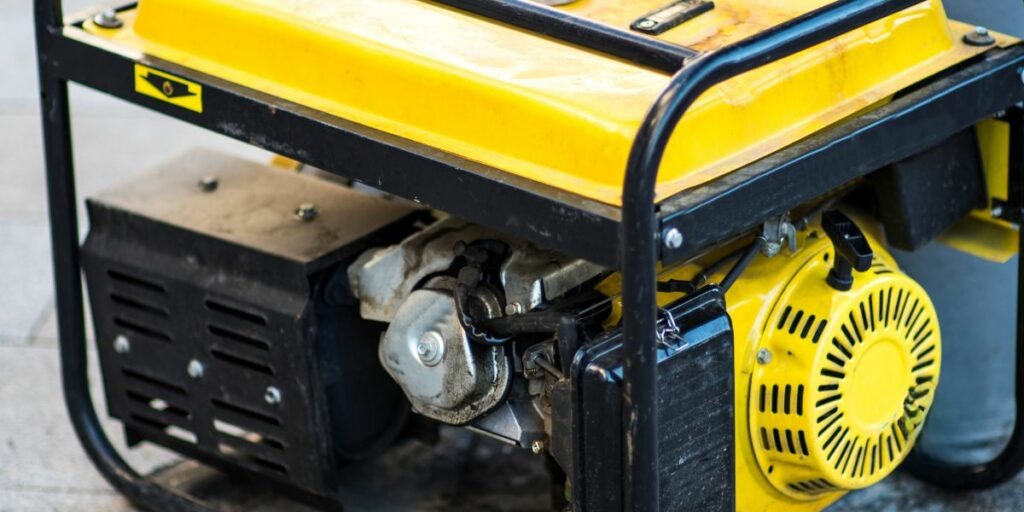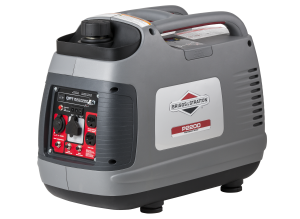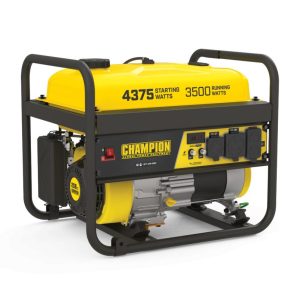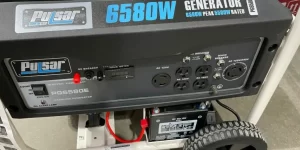The Champion Generator Won’t Start for These 16 Reasons
Power outages, parties, and construction sites all necessitate the use of generators. It can be irritating to try to figure out why your engine won’t start. As a reference, I have supplied a checklist of things to look for when this occurs.
A Champion generator won’t turn over until there is enough gasoline, air, and spark to create an explosion and start the engine.
Possible causes include a faulty fuel filter, a clogged fuel line, a dirty carburetor, a faulty fuel cap, a blocked air filter, a faulty spark plug, a blocked spark arrestor, or simply old gas.
On the following pages, you will find some of the additional potential causes of a problem starting a Champion generator. To fix the engine, first pull the plug and let it cool down.
Table of Contents
Causes Your Champion Generator Won’t Activate
Champion Generator with an empty gas tank
Ensure there is enough gas in the tank for the vehicle to start and run by checking the fuel gauge. This is such a no-brainer, but occasionally folks will ignore the easy explanations and go straight to the complex ones, so I thought I’d point it out.
The fuel tank has to be refilled. The 4-cycle engines used by Champion generators need gasoline to run. Use fuel with no more than 10% ethanol and a minimum 87 octane rating.
Champion Generator Damaged by Old Fuel
The shelf life of gasoline is finite. Specifically, it can start to degrade and become less effective as early as 30 days after purchasing. Worsening fuel limits and component breakdowns are only two of the many issues that might arise from using gas that is a few years old.
These days, most gas stations add ethanol, a renewable fuel, to their gas tanks to reduce their environmental impact. Small engines, like the one in your Champion, shouldn’t use ethanol.
As a result, it’s crucial to avoid using fuel that contains more than 10% ethanol. When used in a fuel system, ethanol attracts moisture. This combination of water and ethanol will eventually dry out and leave behind varnish and sticky residues.
Due to the damage that ethanol can do to a Champion generator, here are some things to bear in mind when buying, storing, and using fuel:
- New gas with at least an 87 octane rating should be purchased (91 RON).
- The maximum allowable percentage of ethanol in gas should never be higher than 10%. Ethanol-free or low-ethanol fuel is preferred.
- Use all fuel within a month.
- If you are not going to use the fuel within 30 days, a fuel stabilizer can extend its shelf life. (New fuel needs to be treated with a fuel stabilizer. Because of this, it cannot be used to counteract the effects of stale fuel.
- Keep gasoline in a sealed, approved fuel container out of the reach of children and pets, and away from anything that could catch fire.
If you discover stale gas in your Champion generator, the solution is to drain the fuel with a fuel siphon pump. Clean the fuel system, lower moisture content, and stabilize new gas by mixing it with a fuel additive.
Putting gas into the 4-cycle engine’s tank. The generator needs to operate for around 15 minutes after it has been started to allow the gas and stabilizer mixture to circulate through the fuel system.
One product I find useful is Sea Foam Motor Treatment. Whenever I fill up my gas tank, I always include this product to mitigate the potential problems caused by ethanol. STA-BIL is an alternative worth considering.
Champion Generator Fuel Filter Clogged
The generator’s fuel filter should be inspected. Installing this filter will prevent harmful debris from entering the fuel system and eventually wearing out the engine.
Eventually, a filter that hasn’t been changed regularly can become so caked with dirt and deposits that it will restrict gasoline flow. As a result of running out of fuel, the generator will be unable to turn on.
The fuel filter should be changed once a year at minimum for the typical residence. If you routinely use the Champion generator, you may need to replace it sooner.
The ANSWER is to get a new gasoline filter for your Champion car if the old one is clogged.
Champion Generator Fuel Line Plugged
Old fuel can leave behind sticky deposits that might choke fuel lines. In order to verify the fuel flow, you must first turn off the gasoline supply and then turn it back on.
Once the fuel has been turned off, the fuel line’s end farthest from the tank should be disconnected and saved. Turn on the fuel and observe how much flows through the line and into the storage tank.
Because fuel can’t flow uphill without a pump, this container needs to be set lower than the Champion’s fuel tank.
If a blockage is found in the fuel line, the problem can be solved by disconnecting the line from the generator and stopping the fuel flow. Apply carburetor cleaner spray and then use compressed air to blow the obstruction out of the line.
The fuel line should be replaced with a new one of the same diameter and length if the restriction cannot be removed or if the line is dry or broken.
A Champion Generator’s Faulty Carburetor
A Champion generator’s carburetor controls the ratio of fuel to air in the combustion chamber during the engine’s starting process.
Components in the carburetor will stop working properly when it becomes dirty from varnish buildup from old fuel. If the fuel jet is clogged, the float is blocked, or the float needle is stuck, your generator may not have enough fuel to start.
Make sure the carburetor is getting enough fuel before you start dismantling it to clean it. If you aren’t, perhaps the fuel filter, fuel line, or fuel pump is restricting the flow of fuel (if your generator uses one).
After determining that the carburetor is the source of the fuel restriction, the problem can be solved by taking it apart and giving it a thorough cleaning. Take out as much gunk as you can from the carburetor by using cleaner.
Check the float, float needle, and fuel jet in the carburetor to ensure sure they are clean and in good working order. A carburetor refurbishment kit or a new carburetor should be used to replace any worn or broken components.
Champion Generator With Clogged Air Filter
By trapping dust and particles in a filter, the air filter safeguards the engine. If the air filter is clogged, fewer air molecules will be able to combine with the gas during combustion.
If you are using the Champion generator in dusty conditions, you should change the air filter more frequently than once a year. Between changes, make sure to clean and inspect the filter.
Without regular maintenance, including cleaning and replacement, the filter can get so clogged with dirt that the engine cannot get enough air to start. The engine could overheat and be severely damaged if this occurs.
If you have a foam air filter and find that it has become clogged, follow the steps outlined below. Look in the instructions if you don’t know how to clean your filter or what kind it is.
Preserve the efficiency of a Champion generator by regularly replacing its foam air filter:
- The air filter needs to be taken out of its housing.
- Air filters should have their housings and covers cleaned of any lingering debris or dust. Keep the air filter free of any dust or debris.
- The foam filter should be checked for wear and replaced if necessary.
- When the water runs clear, you know the filter is clean and ready to be used again.
- Get the excess water out of the filter and set it aside to dry.
- Cover the filter entirely with clean motor oil. Then, compress the filter to drain the extra oil from the engine. Using a paper towel to soak up the oil is another effective method.
- Put in the filter for the air conditioning.
- The air filter cover must be reattached.
Champion Generator Gas Cap Vent Plugged Due to Fuel Tank Impediment
If the gasoline tank doesn’t vent properly, the gas won’t be able to escape. In the event that a vent is blocked, a vacuum will develop inside the tank. This occurs when the vent is blocked and fuel is leaking out of the tank.
The Champion generator will not start if fuel cannot go from the tank to the carburetor.
SOLUTION: If you suspect that the Champion gas cap is preventing the generator from starting, try removing or loosening the cap to let air into the tank.
If the generator starts up and operates OK, then shuts off again after you replace the cap and let it run for a bit, the cap may be at fault. As a rule of thumb, a faulty gas cap should be replaced
Champion generator with a plugged spark arrestor
A Champion generator’s muffler features a spark arrestor screen to prevent sparks from flying out of the exhaust pipe. This metal item is fastened to the muffler and may be seen underneath the vehicle.
In the event that the spark arrestor screen becomes clogged, the generator will have trouble starting and maintaining operation.
Disconnect the spark arrestor wires and take off the screen. Make that the screen is in good condition and free of holes or other damage.
If the spark arrestor still seems to be in good shape, you can reinstall it after cleaning it with a wire brush to get rid of any soot buildup. Get a new screen if the old one looks damaged.
Spark Plug Failure on a Champion Generator.
A malfunctioning spark plug may have a dirty tip, broken porcelain, or a scorched electrode. A Champion generator will not start up in this condition.
A spark plug can have deposits removed from its tip by simply cleaning it. If the tip of your spark plug is severely discolored or damaged, you should get a new one.
The spark plug gap should be adjusted in accordance with the owner’s handbook and the manufacturer’s recommendations. A spark plug with improper gapping or a loose spark plug wire can both contribute to starting difficulties.
Worn-out Champion Generator Ignition Coil Reason for Failure
You should inspect the spark plug before worrying about the ignition coil. Spark plugs require voltage from the ignition coil in order to fire.
A non-firing spark plug or faulty ignition coil will prevent the engine from starting.
The problem can be fixed by using an ohm meter to test the ignition coil’s continuity. Replace the ignition coil if you notice a break in continuity.
Champion Generator With Low Oil Pressure
If the engine oil level becomes too low, the Champion generator will turn off and won’t start. This will prevent severe harm to the engine from not having enough oil to properly operate.
The generator may be damaged if it was run without enough oil and does not have a low engine sensor.
The smooth operation of an engine depends on the lubrication provided by oil. Too little oil in the crankcase causes the oil to thicken, which in turn causes friction and heat.
Solution: Put the generator on a smooth, level surface and check the oil level. The oil can be drained by taking off the fill cap and wiping the dipstick with a dry cloth.
Insert the dipstick back into the oil fill tube but do not tighten the lid. Take the dipstick out and check the oil level. Make sure it’s inside the dipstick’s full range.
If it isn’t, add or drain some oil to get the engine to the proper level. This oil is suitable for use in Kawasaki’s 10W-30 air-cooled engines.
If you check the oil level and find it to be where it should be, yet the low oil sensor continues to illuminate, you may have a malfunctioning sensor. The generator should be taken to a service center for maintenance.
If you notice the oil is low and it still won’t start after you correct it, you may have damaged the engine of your Champion generator, which either doesn’t have a low oil sensor or the sensor failed.
Take it to a shop that specializes in fixing tiny engines so the problem may be properly identified.
Champion Generator’s Choke Is Stuck or Set to the Wrong Position
If you try to start the engine on a cold morning with your Champion generator without first restricting airflow with the choke, you will be very disappointed.
Adjusting the choke lever or dial to the “off” position allows air to flow freely into the carburetor throat, keeping the engine running after it has warmed up.
If you have the choke in the right spot but are still having airflow issues, double check that the plate is opening and closing properly.
Whether your engine won’t start whether it’s cold or warm, check to see if the choke lever is set properly. If the choke is jammed, you can use carburetor cleaning to get it unstuck.
Broken Recoil on a Champion Manually Started Generator
A worn or broken Champion starter recoil makes starting the generator difficult at best. Problems with starting can be caused by a number of factors, including the rope on the recoil becoming unstrung or broken pulley, springs, or clips.
The solution is sometimes as simple as restringing the spring. On sometimes, you may need to repair or replace components of your recoil. Getting the cost of a complete recoil replacement in mind before starting to replace individual parts is a good idea.
It may be more cost-effective to get a new recoil assembly than to take the old one apart and fix the parts that are broken.
A Champion Generator with a Dead Battery (Electric Start)
The battery must be fully charged. You can try charging the battery if it’s low on power. In the event that it stops holding a charge, a new battery should be installed.
Make sure all the wires and cables are connected properly and are fastened firmly.
Solution: If the battery voltage is low, charge the battery. Battery replacement is required for any non-working or non-charging battery.
Champion Generator Faulty Ignition Switch (Electric Start)
A generator that relies on an electric start is susceptible to a switch failure.
Fix: Use a multimeter to check the switch, and if it fails, substitute it.
Champion Generator Starter Solenoid Problems (Electric Start)
If your Champion generator won’t turn on when you press the button or turn the key (depending on your model), you may hear a clicking or humming noise. The wiring could also be overheating and smoking.
These symptoms suggest a faulty solenoid. When the copper plate within the solenoid corrodes or the internal spring becomes too weak, the starter will not turn over. The failure of the solenoid could also be due to an ineffective starter, a dead battery, or an unstable ground.
The solution is to try and power the starter directly from the battery by connecting the two cables using a screwdriver or pliers. Use caution because it could potentially spark.
If the engine can be started without the solenoid, then the solenoid is not the problem.
Before rushing to replace the solenoid, make sure there are no dangling wires or a lack of ground. These are examples of things that could disrupt the solenoid’s normal operation.
Fortunately, most Champion generators that require an electric start also come with a manual starter recoil. If you can get it going by hand, you know the issue isn’t with the battery or the starter.
Read more: Generators








